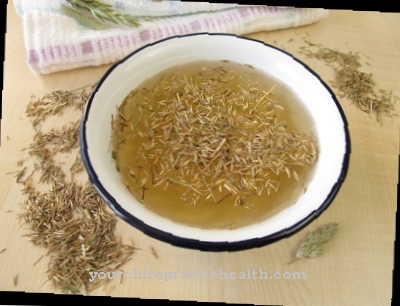The Ordinary easter egg occurs as a wild and garden plant in Central Europe. It is a medicinal plant used since ancient times. Today, due to its poisonous effect, it no longer has any medical significance except in homeopathy.
Occurrence and cultivation of the common easter egg

The yellow, funnel-shaped flowers are three to five inches long. They stand together in the leaf axils of the upper leaves in groups of two to eight flowers. It is characterized by the unpleasant smell of the plant, which attracts flies to pollinate. These slide to the bottom of the flower and, due to the hairiness inside the flower tube, can only come free after pollination, when the flowers wither.
The light green leaves are long-stalked, heart-shaped and six to ten centimeters long and four to seven centimeters wide. The common Easter luzei originally comes from the Mediterranean region. However, it is now found all over Central Europe. The plant likes it warm and sunny. It prefers calcareous, water-permeable and nutrient-rich loam or loess soils. The common easter egg grows mainly in vineyards, alluvial forests, on embankments and field edges.
Effect & application
The rhizome and seeds of the common easter egg contain aristolochic acids, which are also found in smaller quantities in the leaves of the plant. The aristolochic acids are secondary plant substances that are highly toxic. The nitrogen-containing aromatic compounds lead to mutations in the genetic material, are carcinogenic and lead to kidney damage.
In a study, for example, urinary tract tumors were shown in many people in Taiwan who had taken products with the common Easter luzei. In the so-called Balkan nephropathy, aristolochic acids from the seeds of the common Easter lucei, which grew next to grain fields, got into the flour used to bake bread. As a result, they caused kidney disease in many people in the Balkans.
Aristolochic acids can lead to hyperaemia, that is, blood accumulation in organs or tissues. They can also cause menorrhagia (long, heavy menstrual bleeding), i.e. a prolonged and heavy menstrual period, and lead to an abortion during pregnancy. Nevertheless, the aristolochic acids are said to have wound-healing effects and stimulate the immune system. They are said to have anti-inflammatory, antispasmodic and sweat-inducing effects. Insects that feed on plants belonging to the Easter leek family are immune to the effects of aristolochic acids and use them to ward off predators. The common Easter egg also contains essential oils and tannins.
Due to the poisonous effect of the aristolochic acids, drugs with components of the common Easter luzei were banned in Germany. Only homeopathic remedies from potency level D11 are still allowed. The homeopathic remedies are available as globules, tablets and as a solution. Depending on the symptoms, five drops or five globules can be taken three times a day for internal use or the tincture can be used externally.
The fresh, above-ground parts of the plant are used for production. In folk medicine, the common Easter luzei is used externally. For this purpose, the roots harvested in spring or autumn and then dried are boiled and the diluted tincture is applied to eczema, ulcers or itching. Due to the high toxicity, however, finished preparations from homeopathy should be preferred. One should especially warn against herbal mixtures from the Internet that contain common Easter luzei.
Importance for health, treatment & prevention
The common Easter luze, also known as wolfweed or beaverweed, has been known as a medicinal plant since ancient times. The generic name Aristolochia is derived from the Greek “aristos” for “very good” and from “lockeius” for “part of giving birth”. The species name "clematis" comes from the Greek "klema", which means "tendril" and refers to the growth habit.
In ancient times, the common Easter luzei was used for births because the active ingredients should facilitate and accelerate the birth. Since the plant substances can lead to the onset of labor, the easter lucei was also used as an abortion agent. In addition, the common easter egg was used against snakebites. The ancient Egyptian name translates into German as "snake-free". The plant was later used as a medicinal plant in traditional Chinese medicine.
It is still used today in homeopathy for various gynecological complaints, such as menstrual cramps and a feeling of tension and cycle-dependent chest pain, as well as in obstetrics. In addition, homeopathic preparations with the common easter egg are used for internal and external wound healing, for pressure points or blisters, for chronic ulcers and rheumatism.
Before medicines containing Aristolochia were banned, the common Easter luzei was also used in diet cures. If the dosage of the medicinal plant is too high, symptoms of poisoning occur. These can include vomiting, gastrointestinal inflammation, cramps or a high pulse. Blood pressure drops and respiratory paralysis can lead to death. Due to its high toxicity, the common easter lucei no longer plays a major role in medicine as a medicinal plant.
The plant is only used in homeopathy and as an ornamental plant in the garden. Researchers also use aristolochic acids to investigate possible triggers for tumor diseases. The mutations that are triggered by the plant substance can, under certain circumstances, provide indications of the development of tumors.























.jpg)



